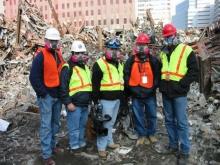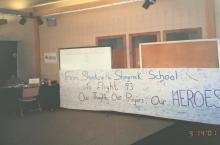Blog
It was six months into the recovery, I was standing in what was left of Tower two. I looked across and there was a group of guys huddled together by what was left of Tower 1… I couldn’t really tell what they were doing but when I got back that night and I looked at my video, I could see that they were performing last rights. Six months after the event and they were still treating every recovery with dignity and respect. It was very humbling to witness that.”
On the morning of September 11, 2001, the skies were clear. Joel Pirrone, now an emergency manager at FEMA’s National Response and Coordination Center, knew that a cloudless sky meant that a plane hitting one of the twin towers was probably not an accident.
Amy Gabriel couldn’t find a song on the radio the morning of September 11, 2001. She was driving four hours to Shanksville, Pennsylvania in a Red Cross vehicle to respond to the Flight 93 tragedy. There was no cassette or CD player in the vehicle, so she had nothing to distract herself from her thoughts.
On Sept. 11, Dan Best was participating in a workgroup to develop a Public Assistance training course at FEMA’s Emergency Management Institute in Emmitsburg, Maryland. Classes and workshops were cancelled, and everyone was told to go home. A Recovery Branch Chief in FEMA Region 7 at the time, Dan let his supervisor know he could either return to the region or assist with the agency’s response to the incident.
No matter where you live in the United States, there are natural hazards known and unknown. While some areas have higher risks, no place has zero risk. From ice storms to volcanic activity, from tornadoes to tsunamis, these natural hazards pose a threat to communities and the human environment. It is important to understand what causes these risks and what you can do to reduce them. The National Risk Index is designed as a user-friendly tool to help individuals and communities gain a deeper understanding of their risks.
The RISE Challenge gives students and opportunity to learn about hazard mitigation and risks where they live. Teams develop projects to improve the resilience of their local communities. Projects are judged and winners receive funds to help make them a reality.
The people of the historic town of Princeville, North Carolina, have experienced major and repetitive flooding events for decades, most recently hurricanes Fran, Floyd and Matthew.
The growing threat of climate change brings more severe weather and disasters. The best way to protect our nation from these threats is to build resilience in our communities. This is the focus of FEMA’s Hazard Mitigation Grant program.
This week, Marcus Coleman was sworn-in as the new director of the DHS Center for Faith-Based Neighborhood Partnerships (DHS Partnerships Center) after his appointment by the Biden-Harris Administration.
Last week, we commemorated the landmark signing of The Americans with Disabilities Act (ADA). The ADA provided a strong foundation for FEMA and our partners to work together to serve disaster survivors with disabilities and ensure equitable access to services and programs, while preserving and promoting the independence of people with disabilities.






